2014 NISSAN QASHQAI light
[x] Cancel search: lightPage 34 of 338
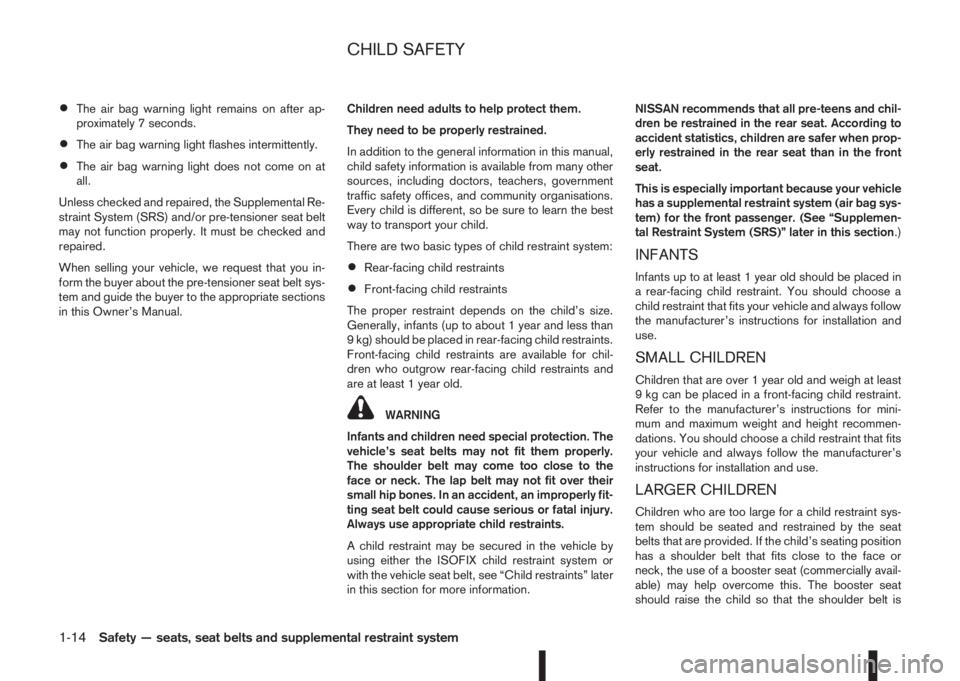
•The air bag warning light remains on after ap-
proximately 7 seconds.
•The air bag warning light flashes intermittently.
•The air bag warning light does not come on at
all.
Unless checked and repaired, the Supplemental Re-
straint System (SRS) and/or pre-tensioner seat belt
may not function properly. It must be checked and
repaired.
When selling your vehicle, we request that you in-
form the buyer about the pre-tensioner seat belt sys-
tem and guide the buyer to the appropriate sections
in this Owner’s Manual.Children need adults to help protect them.
They need to be properly restrained.
In addition to the general information in this manual,
child safety information is available from many other
sources, including doctors, teachers, government
traffic safety offices, and community organisations.
Every child is different, so be sure to learn the best
way to transport your child.
There are two basic types of child restraint system:
•Rear-facing child restraints
•Front-facing child restraints
The proper restraint depends on the child’s size.
Generally, infants (up to about 1 year and less than
9 kg) should be placed in rear-facing child restraints.
Front-facing child restraints are available for chil-
dren who outgrow rear-facing child restraints and
are at least 1 year old.
WARNING
Infants and children need special protection. The
vehicle’s seat belts may not fit them properly.
The shoulder belt may come too close to the
face or neck. The lap belt may not fit over their
small hip bones. In an accident, an improperly fit-
ting seat belt could cause serious or fatal injury.
Always use appropriate child restraints.
A child restraint may be secured in the vehicle by
using either the ISOFIX child restraint system or
with the vehicle seat belt, see “Child restraints” later
in this section for more information.NISSAN recommends that all pre-teens and chil-
dren be restrained in the rear seat. According to
accident statistics, children are safer when prop-
erly restrained in the rear seat than in the front
seat.
This is especially important because your vehicle
has a supplemental restraint system (air bag sys-
tem) for the front passenger. (See “Supplemen-
tal Restraint System (SRS)” later in this section.)
INFANTS
Infants up to at least 1 year old should be placed in
a rear-facing child restraint. You should choose a
child restraint that fits your vehicle and always follow
the manufacturer’s instructions for installation and
use.
SMALL CHILDREN
Children that are over 1 year old and weigh at least
9 kg can be placed in a front-facing child restraint.
Refer to the manufacturer’s instructions for mini-
mum and maximum weight and height recommen-
dations. You should choose a child restraint that fits
your vehicle and always follow the manufacturer’s
instructions for installation and use.
LARGER CHILDREN
Children who are too large for a child restraint sys-
tem should be seated and restrained by the seat
belts that are provided. If the child’s seating position
has a shoulder belt that fits close to the face or
neck, the use of a booster seat (commercially avail-
able) may help overcome this. The booster seat
should raise the child so that the shoulder belt is
CHILD SAFETY
1-14Safety — seats, seat belts and supplemental restraint system
Page 47 of 338
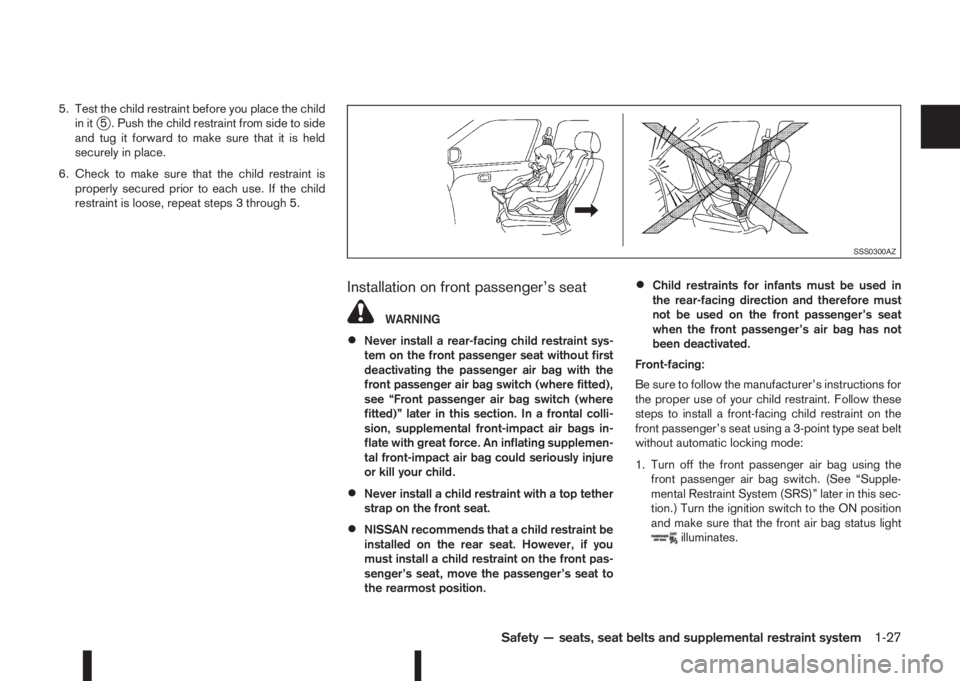
5. Test the child restraint before you place the child
in itj5 . Push the child restraint from side to side
and tug it forward to make sure that it is held
securely in place.
6. Check to make sure that the child restraint is
properly secured prior to each use. If the child
restraint is loose, repeat steps 3 through 5.
Installation on front passenger’s seat
WARNING
•Never install a rear-facing child restraint sys-
tem on the front passenger seat without first
deactivating the passenger air bag with the
front passenger air bag switch (where fitted),
see “Front passenger air bag switch (where
fitted)” later in this section. In a frontal colli-
sion, supplemental front-impact air bags in-
flate with great force. An inflating supplemen-
tal front-impact air bag could seriously injure
or kill your child.
•Never install a child restraint with a top tether
strap on the front seat.
•NISSAN recommends that a child restraint be
installed on the rear seat. However, if you
must install a child restraint on the front pas-
senger’s seat, move the passenger’s seat to
the rearmost position.
•Child restraints for infants must be used in
the rear-facing direction and therefore must
not be used on the front passenger’s seat
when the front passenger’s air bag has not
been deactivated.
Front-facing:
Be sure to follow the manufacturer’s instructions for
the proper use of your child restraint. Follow these
steps to install a front-facing child restraint on the
front passenger’s seat using a 3-point type seat belt
without automatic locking mode:
1. Turn off the front passenger air bag using the
front passenger air bag switch. (See “Supple-
mental Restraint System (SRS)” later in this sec-
tion.) Turn the ignition switch to the ON position
and make sure that the front air bag status light
illuminates.
SSS0300AZ
Safety — seats, seat belts and supplemental restraint system1-27
Page 48 of 338
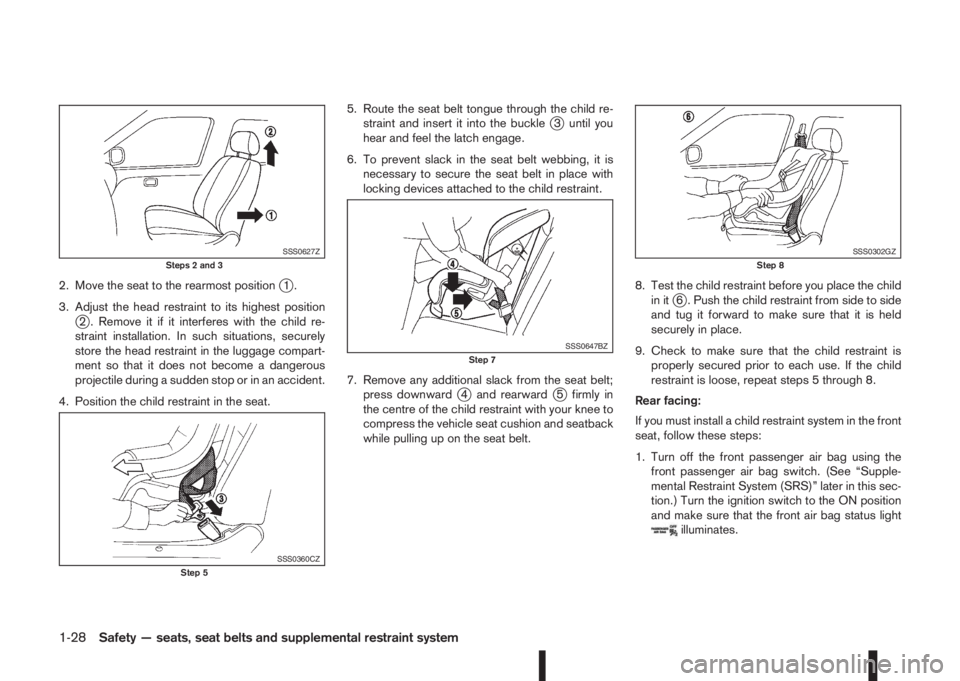
2. Move the seat to the rearmost positionj1.
3. Adjust the head restraint to its highest position
j2 . Remove it if it interferes with the child re-
straint installation. In such situations, securely
store the head restraint in the luggage compart-
ment so that it does not become a dangerous
projectile during a sudden stop or in an accident.
4. Position the child restraint in the seat.5. Route the seat belt tongue through the child re-
straint and insert it into the buckle
j3 until you
hear and feel the latch engage.
6. To prevent slack in the seat belt webbing, it is
necessary to secure the seat belt in place with
locking devices attached to the child restraint.
7. Remove any additional slack from the seat belt;
press downward
j4 and rearwardj5 firmly in
the centre of the child restraint with your knee to
compress the vehicle seat cushion and seatback
while pulling up on the seat belt.8. Test the child restraint before you place the child
in it
j6 . Push the child restraint from side to side
and tug it forward to make sure that it is held
securely in place.
9. Check to make sure that the child restraint is
properly secured prior to each use. If the child
restraint is loose, repeat steps 5 through 8.
Rear facing:
If you must install a child restraint system in the front
seat, follow these steps:
1. Turn off the front passenger air bag using the
front passenger air bag switch. (See “Supple-
mental Restraint System (SRS)” later in this sec-
tion.) Turn the ignition switch to the ON position
and make sure that the front air bag status light
illuminates.
SSS0627ZSteps 2 and 3
SSS0360CZStep 5
SSS0647BZStep 7
SSS0302GZStep 8
1-28Safety — seats, seat belts and supplemental restraint system
Page 50 of 338
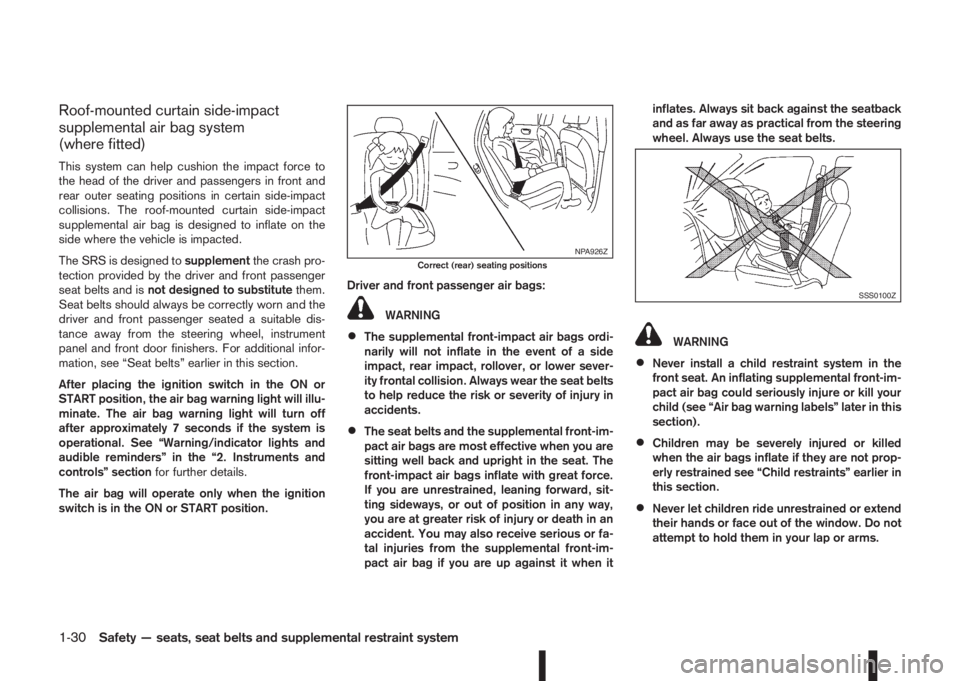
Roof-mounted curtain side-impact
supplemental air bag system
(where fitted)
This system can help cushion the impact force to
the head of the driver and passengers in front and
rear outer seating positions in certain side-impact
collisions. The roof-mounted curtain side-impact
supplemental air bag is designed to inflate on the
side where the vehicle is impacted.
The SRS is designed tosupplementthe crash pro-
tection provided by the driver and front passenger
seat belts and isnot designed to substitutethem.
Seat belts should always be correctly worn and the
driver and front passenger seated a suitable dis-
tance away from the steering wheel, instrument
panel and front door finishers. For additional infor-
mation, see “Seat belts” earlier in this section.
After placing the ignition switch in the ON or
START position, the air bag warning light will illu-
minate. The air bag warning light will turn off
after approximately 7 seconds if the system is
operational. See “Warning/indicator lights and
audible reminders” in the “2. Instruments and
controls” sectionfor further details.
The air bag will operate only when the ignition
switch is in the ON or START position.Driver and front passenger air bags:
WARNING
•The supplemental front-impact air bags ordi-
narily will not inflate in the event of a side
impact, rear impact, rollover, or lower sever-
ity frontal collision. Always wear the seat belts
to help reduce the risk or severity of injury in
accidents.
•The seat belts and the supplemental front-im-
pact air bags are most effective when you are
sitting well back and upright in the seat. The
front-impact air bags inflate with great force.
If you are unrestrained, leaning forward, sit-
ting sideways, or out of position in any way,
you are at greater risk of injury or death in an
accident. You may also receive serious or fa-
tal injuries from the supplemental front-im-
pact air bag if you are up against it when itinflates. Always sit back against the seatback
and as far away as practical from the steering
wheel. Always use the seat belts.
WARNING
•Never install a child restraint system in the
front seat. An inflating supplemental front-im-
pact air bag could seriously injure or kill your
child (see “Air bag warning labels” later in this
section).
•Children may be severely injured or killed
when the air bags inflate if they are not prop-
erly restrained see “Child restraints” earlier in
this section.
•Never let children ride unrestrained or extend
their hands or face out of the window. Do not
attempt to hold them in your lap or arms.
NPA926ZCorrect (rear) seating positions
SSS0100Z
1-30Safety — seats, seat belts and supplemental restraint system
Page 52 of 338

The BACK SEAT is the SAFEST place for children
aged 12 and under. Always use seat belts and
child restraints. For maximum safety protection
in all types of crashes, you must always wear
your safety belt. Do not sit or lean unnecessarily
close to the airbag. Do not place any objects over
the airbag or between the airbag and yourself. If
the airbag warning light stays on or is flashing
when the ignition switch is placed in the ON posi-
tion, go to a NISSAN dealer or qualified work-
shop. Airbags can only be removed or disposed
of by a NISSAN dealer or qualified workshop.
Be sure to read the “AIRBAG LABEL” description
at the end of this manual.
In vehicles equipped with a front-impact passenger
air bag system, use a rear-facing child restraint sys-
tem only on the rear seats.
When installing a child restraint system in your ve-
hicle, always follow the child restraint system manu-
facturer’s instructions for installation. For informa-
tion, see “Child restraints” earlier in this section.SRS air bag warning light
The SRS air bag warning light, displayingin
the instrument panel, monitors the circuits of the
supplemental front-impact air bag, front seat-
mounted side-impact supplemental air bag (where
fitted), supplemental curtain side-impact air bags
(where fitted), and pre-tensioner seat belt systems.
The circuits monitored by the SRS air bag warning
light are the diagnosis sensor unit, crash zone sen-
sor, satellite sensors, front impact air bag modules,
front seat-mounted side-impact supplemental air
bag modules (where fitted), roof-mounted curtain
side-impact supplemental air bag modules (where
fitted), pre-tensioner seat belt systems, and all re-
lated wiring.
After placing the ignition switch in the ON or
START position, the supplemental air bag warn-
ing light illuminates. The air bag warning light will
turn off after approximately 7 seconds if the sys-
tem is operational.Have the air bag systems and/or pre-tensioner seat
belt systems serviced at the nearest NISSAN dealer
or qualified workshop if any of the following condi-
tions occur:
•The SRS air bag warning light remains on after
approximately 7 seconds.
•The SRS air bag warning light flashes intermit-
tently.
•The SRS air bag warning light does not illumi-
nate at all.
Under these conditions, the air bag systems and/or
pre-tensioner seat belt systems may not operate
properly. They must be checked and repaired. Con-
tact a NISSAN dealer or qualified workshop imme-
diately.
NPA1295
1-32Safety — seats, seat belts and supplemental restraint system
Page 54 of 338
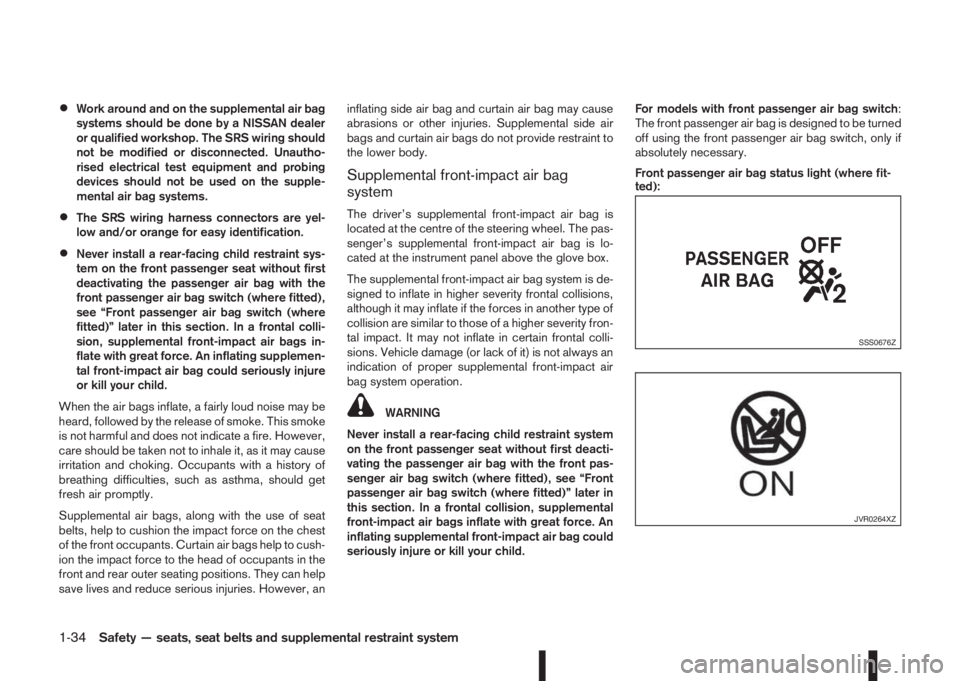
•Work around and on the supplemental air bag
systems should be done by a NISSAN dealer
or qualified workshop. The SRS wiring should
not be modified or disconnected. Unautho-
rised electrical test equipment and probing
devices should not be used on the supple-
mental air bag systems.
•The SRS wiring harness connectors are yel-
low and/or orange for easy identification.
•Never install a rear-facing child restraint sys-
tem on the front passenger seat without first
deactivating the passenger air bag with the
front passenger air bag switch (where fitted),
see “Front passenger air bag switch (where
fitted)” later in this section. In a frontal colli-
sion, supplemental front-impact air bags in-
flate with great force. An inflating supplemen-
tal front-impact air bag could seriously injure
or kill your child.
When the air bags inflate, a fairly loud noise may be
heard, followed by the release of smoke. This smoke
is not harmful and does not indicate a fire. However,
care should be taken not to inhale it, as it may cause
irritation and choking. Occupants with a history of
breathing difficulties, such as asthma, should get
fresh air promptly.
Supplemental air bags, along with the use of seat
belts, help to cushion the impact force on the chest
of the front occupants. Curtain air bags help to cush-
ion the impact force to the head of occupants in the
front and rear outer seating positions. They can help
save lives and reduce serious injuries. However, aninflating side air bag and curtain air bag may cause
abrasions or other injuries. Supplemental side air
bags and curtain air bags do not provide restraint to
the lower body.
Supplemental front-impact air bag
system
The driver’s supplemental front-impact air bag is
located at the centre of the steering wheel. The pas-
senger’s supplemental front-impact air bag is lo-
cated at the instrument panel above the glove box.
The supplemental front-impact air bag system is de-
signed to inflate in higher severity frontal collisions,
although it may inflate if the forces in another type of
collision are similar to those of a higher severity fron-
tal impact. It may not inflate in certain frontal colli-
sions. Vehicle damage (or lack of it) is not always an
indication of proper supplemental front-impact air
bag system operation.
WARNING
Never install a rear-facing child restraint system
on the front passenger seat without first deacti-
vating the passenger air bag with the front pas-
senger air bag switch (where fitted), see “Front
passenger air bag switch (where fitted)” later in
this section. In a frontal collision, supplemental
front-impact air bags inflate with great force. An
inflating supplemental front-impact air bag could
seriously injure or kill your child.For models with front passenger air bag switch:
The front passenger air bag is designed to be turned
off using the front passenger air bag switch, only if
absolutely necessary.
Front passenger air bag status light (where fit-
ted):
SSS0676Z
JVR0264XZ
1-34Safety — seats, seat belts and supplemental restraint system
Page 55 of 338
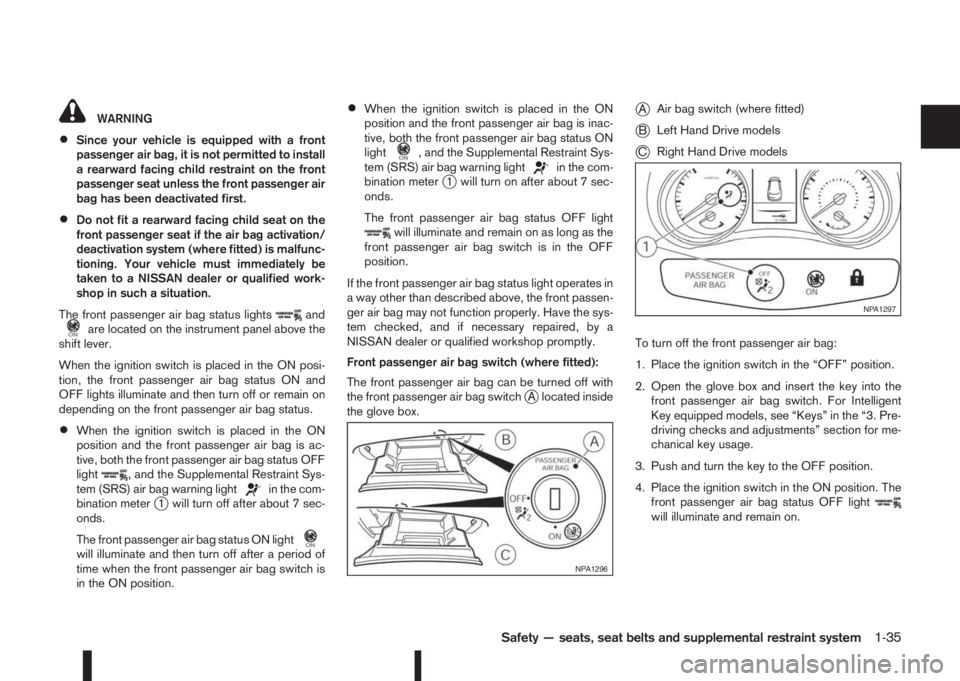
WARNING
•Since your vehicle is equipped with a front
passenger air bag, it is not permitted to install
a rearward facing child restraint on the front
passenger seat unless the front passenger air
bag has been deactivated first.
•Do not fit a rearward facing child seat on the
front passenger seat if the air bag activation/
deactivation system (where fitted) is malfunc-
tioning. Your vehicle must immediately be
taken to a NISSAN dealer or qualified work-
shop in such a situation.
The front passenger air bag status lights
andare located on the instrument panel above the
shift lever.
When the ignition switch is placed in the ON posi-
tion, the front passenger air bag status ON and
OFF lights illuminate and then turn off or remain on
depending on the front passenger air bag status.
•When the ignition switch is placed in the ON
position and the front passenger air bag is ac-
tive, both the front passenger air bag status OFF
light
, and the Supplemental Restraint Sys-
tem (SRS) air bag warning lightin the com-
bination meterj1 will turn off after about 7 sec-
onds.
The front passenger air bag status ON light
will illuminate and then turn off after a period of
time when the front passenger air bag switch is
in the ON position.
•When the ignition switch is placed in the ON
position and the front passenger air bag is inac-
tive, both the front passenger air bag status ON
light
, and the Supplemental Restraint Sys-
tem (SRS) air bag warning lightin the com-
bination meterj1 will turn on after about 7 sec-
onds.
The front passenger air bag status OFF light
will illuminate and remain on as long as the
front passenger air bag switch is in the OFF
position.
If the front passenger air bag status light operates in
a way other than described above, the front passen-
ger air bag may not function properly. Have the sys-
tem checked, and if necessary repaired, by a
NISSAN dealer or qualified workshop promptly.
Front passenger air bag switch (where fitted):
The front passenger air bag can be turned off with
the front passenger air bag switch
jA located inside
the glove box.
jAAir bag switch (where fitted)
jBLeft Hand Drive models
jCRight Hand Drive models
To turn off the front passenger air bag:
1. Place the ignition switch in the “OFF” position.
2. Open the glove box and insert the key into the
front passenger air bag switch. For Intelligent
Key equipped models, see “Keys” in the “3. Pre-
driving checks and adjustments” section for me-
chanical key usage.
3. Push and turn the key to the OFF position.
4. Place the ignition switch in the ON position. The
front passenger air bag status OFF light
will illuminate and remain on.
NPA1296
NPA1297
Safety — seats, seat belts and supplemental restraint system1-35
Page 56 of 338
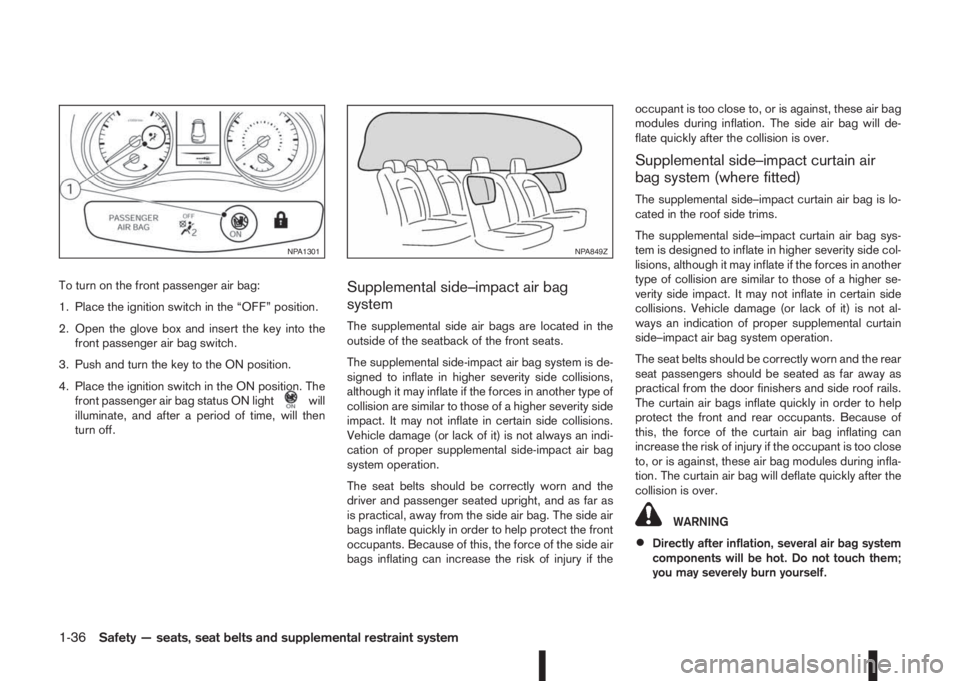
To turn on the front passenger air bag:
1. Place the ignition switch in the “OFF” position.
2. Open the glove box and insert the key into the
front passenger air bag switch.
3. Push and turn the key to the ON position.
4. Place the ignition switch in the ON position. The
front passenger air bag status ON light
will
illuminate, and after a period of time, will then
turn off.
Supplemental side–impact air bag
system
The supplemental side air bags are located in the
outside of the seatback of the front seats.
The supplemental side-impact air bag system is de-
signed to inflate in higher severity side collisions,
although it may inflate if the forces in another type of
collision are similar to those of a higher severity side
impact. It may not inflate in certain side collisions.
Vehicle damage (or lack of it) is not always an indi-
cation of proper supplemental side-impact air bag
system operation.
The seat belts should be correctly worn and the
driver and passenger seated upright, and as far as
is practical, away from the side air bag. The side air
bags inflate quickly in order to help protect the front
occupants. Because of this, the force of the side air
bags inflating can increase the risk of injury if theoccupant is too close to, or is against, these air bag
modules during inflation. The side air bag will de-
flate quickly after the collision is over.
Supplemental side–impact curtain air
bag system (where fitted)
The supplemental side–impact curtain air bag is lo-
cated in the roof side trims.
The supplemental side–impact curtain air bag sys-
tem is designed to inflate in higher severity side col-
lisions, although it may inflate if the forces in another
type of collision are similar to those of a higher se-
verity side impact. It may not inflate in certain side
collisions. Vehicle damage (or lack of it) is not al-
ways an indication of proper supplemental curtain
side–impact air bag system operation.
The seat belts should be correctly worn and the rear
seat passengers should be seated as far away as
practical from the door finishers and side roof rails.
The curtain air bags inflate quickly in order to help
protect the front and rear occupants. Because of
this, the force of the curtain air bag inflating can
increase the risk of injury if the occupant is too close
to, or is against, these air bag modules during infla-
tion. The curtain air bag will deflate quickly after the
collision is over.
WARNING
•Directly after inflation, several air bag system
components will be hot. Do not touch them;
you may severely burn yourself.
NPA1301NPA849Z
1-36Safety — seats, seat belts and supplemental restraint system